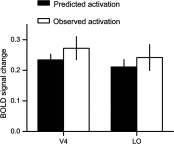Modulations of emotional attention and spatial attention on human visual cortical activities
- PMID: 31191058
- PMCID: PMC6529676
- DOI: 10.2147/PRBM.S188121
Modulations of emotional attention and spatial attention on human visual cortical activities
Abstract
Background: Spatial attention could enhance the neural activities of attended locations in human visual cortex. As a salient stimulus, emotional image could enhance the responses in amygdala and visual areas. However, few studies examined the interaction of the attentional effects induced by emotional stimuli and spatial cues on the neural responses in visual areas. Methods: In the present study, we used functional magnetic resonance imaging (fMRI) to examine the combined and separated effects of emotional image and spatial cue on the activities in human visual areas. A revised Posner cueing paradigm was utilized. Each participant viewed a fearful image and a peaceful image simultaneously in left and right visual fields. A spatial cue of two dots was then presented in one of the image positions. In this manner, the attentional effects for emotional image and spatial cue could be isolated and combined. Results: The results showed that spatial cue enhanced the responses in V4, intraparietal sulcus (IPS) and lateral occipital area (LO), while emotional image could enhance the responses in V3, V4 and LO. Importantly, no significant interactions were found in any of the visual areas. Conclusion: Our results indicate that the two kinds of attentional modulation might not be affected by each other. These findings shed light on the neural mechanism of the emotional attention.
Keywords: emotional attention; fMRI; spatial attention; visual cortex.
Conflict of interest statement
The authors report no conflict of interest in this work.
Figures



Similar articles
-
Dynamics of emotional effects on spatial attention in the human visual cortex.Prog Brain Res. 2006;156:67-91. doi: 10.1016/S0079-6123(06)56004-2. Prog Brain Res. 2006. PMID: 17015075 Review.
-
Neural systems for orienting attention to the location of threat signals: an event-related fMRI study.Neuroimage. 2006 Jun;31(2):920-33. doi: 10.1016/j.neuroimage.2005.12.034. Epub 2006 Feb 17. Neuroimage. 2006. PMID: 16487729
-
Cortical and Subcortical Coordination of Visual Spatial Attention Revealed by Simultaneous EEG-fMRI Recording.J Neurosci. 2017 Aug 16;37(33):7803-7810. doi: 10.1523/JNEUROSCI.0326-17.2017. Epub 2017 Jul 11. J Neurosci. 2017. PMID: 28698387 Free PMC article.
-
A functional MRI study of preparatory signals for spatial location and objects.Neuropsychologia. 2005;43(14):2041-56. doi: 10.1016/j.neuropsychologia.2005.03.020. Epub 2005 Apr 26. Neuropsychologia. 2005. PMID: 16243051
-
Distributed and interactive brain mechanisms during emotion face perception: evidence from functional neuroimaging.Neuropsychologia. 2007 Jan 7;45(1):174-94. doi: 10.1016/j.neuropsychologia.2006.06.003. Epub 2006 Jul 18. Neuropsychologia. 2007. PMID: 16854439 Review.
Cited by
-
Longitudinal hippocampal circuit change differentiates persistence and remission of pediatric posttraumatic stress disorder.Depress Anxiety. 2022 Jan;39(1):8-18. doi: 10.1002/da.23229. Epub 2021 Nov 29. Depress Anxiety. 2022. PMID: 34843625 Free PMC article.
-
The Effect of Empathy on the Attentional Processing of Painful and Emotional Stimuli.Psychol Res Behav Manag. 2021 Aug 10;14:1223-1234. doi: 10.2147/PRBM.S318657. eCollection 2021. Psychol Res Behav Manag. 2021. PMID: 34408507 Free PMC article.
References
-
- Posner MI. Components of visual orienting. Attention Perform X Hillsdale. 1984;32(4):531–556.
-
- Kastner S, Pinsk MA, De Weerd P, Desimone R, Ungerleider LG. Increased activity in human visual cortex during directed attention in the absence of visual stimulation. Neuron. 1999;22(4):751–761. - PubMed
LinkOut - more resources
Full Text Sources
Research Materials

